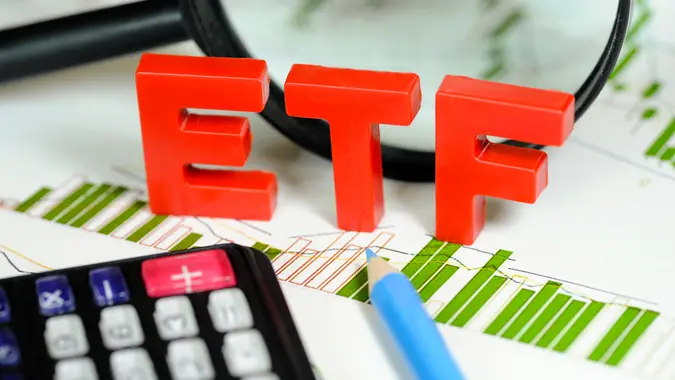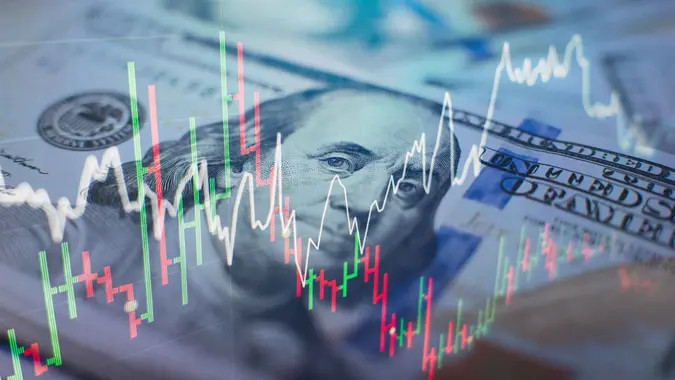7 Best Commodity ETFs To Invest In Right Now

Commitment to Our Readers
GOBankingRates' editorial team is committed to bringing you unbiased reviews and information. We use data-driven methodologies to evaluate financial products and services - our reviews and ratings are not influenced by advertisers. You can read more about our editorial guidelines and our products and services review methodology.

20 Years
Helping You Live Richer

Reviewed
by Experts

Trusted by
Millions of Readers
One of the main advantages of exchange-traded funds is that you can use them to gain exposure to a particular sector of the market. This is especially valuable if you’re looking to invest in commodities, which are often quite volatile and may be hard to invest in as a retail investor.
Check Out: 5 Subtly Genius Moves All Wealthy People Make With Their Money
7 Best Commodity ETFs in 2025
If you’re looking to own commodities in 2025, here are some of the best commodity ETFs that you can buy.
Funds were selected on a combination of commonly used evaluation methods, including size, tracking error, industry coverage, liquidity, performance and analyst ratings.
| ETF | Ticker | Expense Ratio | 1-Year Return |
|---|---|---|---|
| Invesco DB Commodity Index Tracking Fund | (DBC) | 0.85% | -12.19% |
| iShares Silver Trust | (SLV) | 0.50% | 11.32% |
| Invesco DB Agriculture Fund | (DBA) | 0.85% | 1.97% |
| SPDR Gold Shares | (GLD) | 0.40% | 34.67% |
| United States 12 Month Oil Fund LP | (USL) | 0.79% | -20.13% |
| Teucrium Corn Fund | (CORN) | 1.00% | -1.66% |
| United States Copper Index Fund, LP | (CPER) | 1.04% | 5.87% |
Good To Know
Commodities are often seen as a hedge against inflation — one reason they continue to attract investors.
While inflation has cooled, it was still elevated at 2.4% in March 2025, making commodity ETFs a potential inflation buffer.
1. Invesco DB Commodity Index Tracking Fund (DBC)
The Invesco DB Commodity Index Tracking Fund tracks futures contracts on 14 of the most heavily traded and important physical commodities in the world. Currently, this includes commodities ranging from:
- Oil
- Wheat
- Copper
- Gold
- Silver
- Natural gas
- Soybeans
2. iShares Silver Trust (SLV)
If you’re looking for a pure play on the silver market, look no further than the iShares Silver Trust.
- This fund holds silver bullion and tracks price movements in the market directly.
- It’s one of the largest and most liquid of all commodity ETFs.
- Many investors like silver because in addition to its jewelry use, it’s also very useful for industrial and commercial applications, which contributes to its solid historical performance over the short and long term.
3. Invesco DB Agriculture Fund (DBA)
Those looking to invest in agriculture without having to pick a specific commodity within that sector can use an ETF like the Invesco DB Agriculture Fund.
- This ETF provides investors with exposure to a wide range of agricultural raw materials, from sugar and corn to cattle, soybeans, wheat and others.
- Just three commodities, coffee, live cattle and cocoa, currently make up over 40% of the portfolio.
- While this index fund aims to track its benchmark, it has slightly outperformed thanks to interest income from Treasurys and other holdings.
4. SPDR Gold Shares (GLD)
Precious metals are popular commodities for individual investors. This makes the SPDR Gold Shares ETF one of the best commodity ETFs for 2025.
- It’s a good way for retail investors to gain exposure to gold because it can be difficult and cumbersome to buy and store individual gold bars or coins.
- Fully backed by physical gold, the fund is the largest of its kind and has one of the lowest expense ratios.
- Gold has surged over the past year, boosting the fund’s price — and since its 2004 launch, it has delivered an annualized return of over 9%.
5. United States 12 Month Oil Fund LP (USL)
The United States 12 Month Oil Fund LP is about as straightforward of an ETF as you can find.
- All USL does is track the price movements of West Texas Intermediate light, sweet crude oil.
- The fund tracks oil prices by investing in near-month WTI futures and contracts for the next 11 months, using the daily average of all 12 equally weighted.
- Shares trade on the NYSE Arca exchange.
- The fund’s value has risen over five and 10 years but has a 1.54% annualized loss since inception.
6. Teucrium Corn Fund (CORN)
Agricultural products are another type of commodity that is popular for investors but can be hard to acquire individually. For example, if you want to place a bet on the direction of the price of corn, it’s much more realistic to buy the Teucrium Corn Fund than to physically buy bushels of corn.
- The Teucrium Corn Fund tracks the price of corn futures.
- Corn futures historically have a low correlation with the price of U.S. stocks and can be a good diversification tool.
- The fund has positive five-year annualized returns but has seen losses year to date and over three years.
7. United States Copper Index Fund, LP (CPER)
The United States Copper Index Fund tracks daily changes in the SummerHaven Copper Index Total Return.
- It tracks one to three selected futures contracts each month and rebalances its holding monthly.
- This ETF is a pure play on the price of one of the most useful and actively traded metals in the country.
- It has seen gains over one, five and 10 years.
Why Invest In Commodity ETFs?
Commodities can be an attractive option for investors who want to diversify their stock and bond holdings with a hedge against inflation. Here are some points to know:
- Whereas stocks and bonds tend to fall when inflation is high, commodities generally move in the same direction as inflation.
- Commodities tend to move in the same direction as stocks at some times and in the opposite direction at others.
- Investing in a commodity ETF gives you access to investments that may be difficult for an individual investor to otherwise acquire.
- Buying physical gold and silver, for example, is relatively easy, but it involves finding a dealer that doesn’t charge an excessive markup and then paying for storage of your bullion, or storing yourself in a home safe.
- Similarly, trading coffee or orange juice futures might be too niche for the average investor, but owning a commodity ETF doesn’t require any specific knowledge or ability.
- Commodity ETFs are also highly liquid and don’t require any margin or leverage restrictions.
Commodity ETFs vs. Other Investment Options
Commodities ETFs are risky, so it’s a good idea to consider other types of assets before you invest.
- Real estate investment trusts:
- REITS are companies that invest in real estate or real estate debt.
- They’re an alternative investment, like commodities, but generally speaking, they’re less volatile.
- Their correlation with stocks is modest.
- Commodity-related stocks:
- Rather than invest in a commodity, you can invest in a company whose business is involved with the commodity.
- Some examples are an oil company or a gold mining company.
- That way, your investment is impacted more by the companies’ financial strength than the commodities markets.
| Characteristic | Commodity ETFs | REITs | Commodity-Related Stocks |
|---|---|---|---|
| Volatility | Very high | Modest | High |
| Correlation to stock market | Generally low but varies between negative and positive | Positive but modest correlation | N/A |
| Inflation hedge | Yes | Yes | Yes |
Risks of Investing in Commodity ETFs
The risks of investing in commodities ETFs are that they can be highly volatile, and they don’t derive their price from the standard metrics used in evaluating stocks, such as revenue and earnings growth.
Commodities can be more volatile than stocks, with prices influenced by everything from interest rates and inflation to weather events and market sentiment — making them harder to predict.
Trends Shaping Commodities in 2025
Commodities span multiple industries, making it tough to pin down a single trend affecting them all.
According to Fidelity, prices are especially sensitive to regulation, competition and current events.
Because of their complexity and volatility, professionals caution inexperienced investors against investing in them.
How To Buy Commodity ETFs: 4-Step Guide
You can invest in commodities ETFs just as if you were buying a stock. Any broker or financial services firm that allows stock trades will give you access to all of the commodity ETFs listed above.
Here’s how to invest.
- Select a brokerage platform and then register and fund your trading account.
- Use your broker’s ETF screener to identify commodity ETFs.
- Research the ETFs you’re interested in investing in using the fund information on the brokerage site as well as news reports in the financial press.
- When you’re ready to buy, call up the ETF you want to invest in and select the “buy” button.
FAQ
Here are the answers to some commonly asked questions about commodity ETFs.- What are the best commodity ETFs for beginners?
- Experts warn beginners against investing in commodities, but you might consider a small investment in gold through SPDR Gold Shares or a similar ETF.
- Should I invest in commodity ETFs in 2025?
- That depends on your investment goals and risk tolerance.
- Commodities are highly volatile investments, so you stand a good chance of losing money. But they can also hedge against inflation and volatility in the stock and bond markets.
- If you're unsure whether commodities are the right choice for you, consult with a fee-based financial advisor before you invest.
- Which commodity ETFs pay dividends?
- The Invesco DB Commodity Index Tracking Fund and Invesco DB Agriculture Fund pay dividends.
- Are commodity ETFs good for long-term growth?
- Generally speaking, no. As an asset class, commodity prices don't necessarily trend upward over time like stocks historically have, and they're much riskier. And many commodity ETFs invest in futures contracts, which expire. If the ETF price declines and doesn't recover before the contract expires, you lose any chance of recouping your loss.
Information is accurate as of April 15, 2025.
Cynthia Measom and John Csiszar contributed to the reporting for this article.
Our in-house research team and on-site financial experts work together to create content that’s accurate, impartial, and up to date. We fact-check every single statistic, quote and fact using trusted primary resources to make sure the information we provide is correct. You can learn more about GOBankingRates’ processes and standards in our editorial policy.
- Charles Schwab. 2025. "How to Buy Gold to Diversify Your Portfolio."
- Vanguard. "What are alternative investments?"
- Coleman Dunleavy. "Equity REITs: Is There Room for Real Estate in Your Portfolio?"
- Sortis Capital. 2024. "REITs v/s Other Financial Instruments."
- Fidelity. "What is commodity investing?"
- Commodity Futures Trading Commission. "Customer Advisory: Learn About Risks Before Investing in Commodity ETPs or Funds"
- Bureau of Labor Statistics. 2025. "CONSUMER PRICE INDEX."
 Written by
Written by  Edited by
Edited by 

























